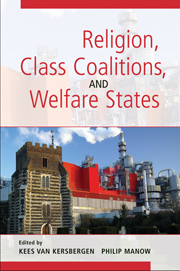Book contents
- Frontmatter
- Contents
- Preface
- List of Contributors
- 1 Religion and the Western Welfare State – The Theoretical Context
- 2 Western European Party Systems and the Religious Cleavage
- 3 The Religious Foundations of Work-Family Policies in Western Europe
- 4 Italy: A Christian Democratic or Clientelist Welfare State?
- 5 Religion and the Welfare State in the Netherlands
- 6 A Conservative Welfare State Regime without Christian Democracy? The French État-Providence, 1880–1960
- 7 Religion and the Consolidation of the Swiss Welfare State, 1848–1945
- 8 The Church as Nation? The Role of Religion in the Development of the Swedish Welfare State
- 9 The Religious Factor in U.S. Welfare State Politics
- 10 Religious Doctrines and Poor Relief: A Different Causal Pathway
- Index
4 - Italy: A Christian Democratic or Clientelist Welfare State?
Published online by Cambridge University Press: 28 January 2010
- Frontmatter
- Contents
- Preface
- List of Contributors
- 1 Religion and the Western Welfare State – The Theoretical Context
- 2 Western European Party Systems and the Religious Cleavage
- 3 The Religious Foundations of Work-Family Policies in Western Europe
- 4 Italy: A Christian Democratic or Clientelist Welfare State?
- 5 Religion and the Welfare State in the Netherlands
- 6 A Conservative Welfare State Regime without Christian Democracy? The French État-Providence, 1880–1960
- 7 Religion and the Consolidation of the Swiss Welfare State, 1848–1945
- 8 The Church as Nation? The Role of Religion in the Development of the Swedish Welfare State
- 9 The Religious Factor in U.S. Welfare State Politics
- 10 Religious Doctrines and Poor Relief: A Different Causal Pathway
- Index
Summary
Is the welfare state in Italy, a quintessentially Christian Democratic polity, a ‘Christian Democratic welfare state (CDWS)?’ The Italian welfare state has most, if not all, of the hallmarks of what is often referred to in the comparative welfare state literature as a CDWS: contributory social insurance programs linked to occupation that reproduce status differentials, a predominance of transfers over services, low female force participation, and low employment rates among others. The key explanation in the comparative literature for the emergence of these features in a number of countries has been Christian Democratic party strength, usually measured as ‘government participation of Christian Democratic parties’ (Huber et al. 1993; Huber and Stephens 2001). In Italy, both the institutional features and the political strength of Democrazia Cristiana ([DC], i.e., the Christian Democratic party) are undeniably present, lending plausibility to the argument that Christian Democracy built the Italian welfare state.
Yet, this view of the Italian welfare state as organically related to the political strength of a Christian Democratic party does not, I argue, concern itself adequately with the mechanisms by which Christian Democracy as a political phenomenon becomes translated into welfare state structures. Indeed, it tells us little about how Christian Democratic parties may have created homologous welfare states, as distinct from the welfare states constructed in polities dominated by social democratic or liberal parties.
A second strain of thought in the comparative literature has done more to uncover the causal mechanisms at work (Becker and van Kersbergen 1988; Esping-Andersen 1990, 1998; van Kersbergen 1995).
- Type
- Chapter
- Information
- Religion, Class Coalitions, and Welfare States , pp. 91 - 118Publisher: Cambridge University PressPrint publication year: 2009
- 10
- Cited by



